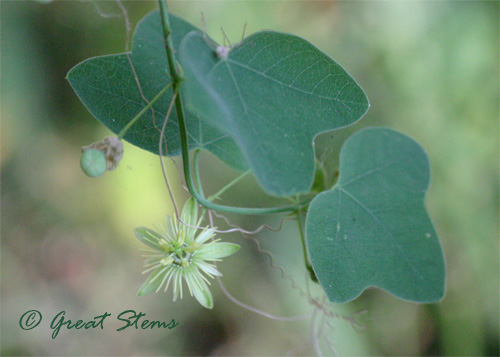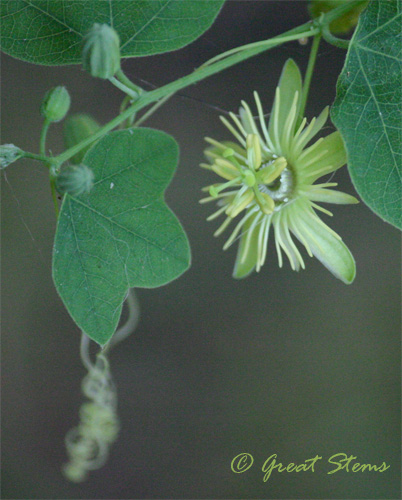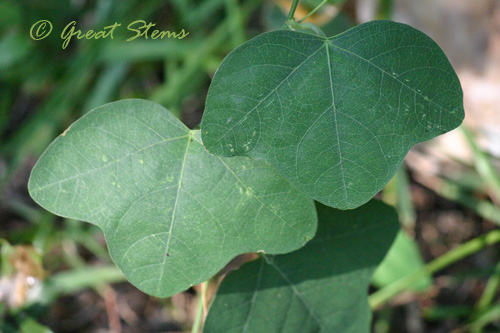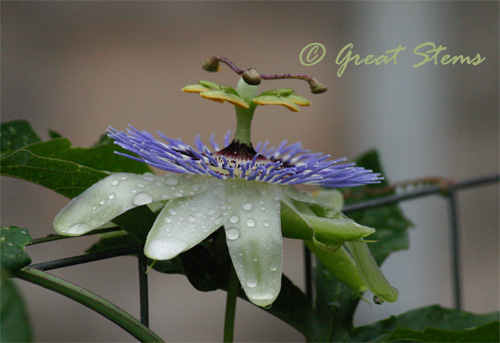Oh, hey, it’s raining. And I know why. It’s because it’s my watering day (city schedule), and I actually took the time to water this morning. You know what happened last time I took the time to water? Yep, it rained. Yes, Murphy’s Law continues to be in full effect at Great Stems. Also, my son left the electric mower out in the backyard, with the cord still plugged in. That perhaps added to the rain potential. I know I’m repeating myself about this, but hey, whatever it takes to get some rain around here!
Regardless of my pitiful attempt to water this morning, my plants needed the extra drink from the rain and the overcast relief from the 100+ weather and full Texas sun we’ve had lately. The plants I didn’t get to water are right now grateful that nature took pity on them, since I melted in the morning heat and had to stop.
Today I want to highlight a happy little vine I’ve found growing and blooming in my yard. This is one of our native Passionvines — Passiflora lutea — also known as Yellow Passionflower.
 It puts out this adorable miniature version of the larger, better known Passionvine flower, with yellow-green as its primary color. The flower is about 1/2 inch in diameter. Just as cute as a button!
It puts out this adorable miniature version of the larger, better known Passionvine flower, with yellow-green as its primary color. The flower is about 1/2 inch in diameter. Just as cute as a button!
 The leaves of the Yellow Passionflower are gently three-lobed and easy to distinguish. They are hosts to many butterfly species — including fritillary and longwing species.
The leaves of the Yellow Passionflower are gently three-lobed and easy to distinguish. They are hosts to many butterfly species — including fritillary and longwing species.
 As is often my luck, or more Murphy’s Law perhaps, the Yellow Passionflower plants I actually purchased are very small, while the largest vine on the property is the one that just showed up on its own. I’ve already seen a fritillary caterpillar on one of them — yay.
As is often my luck, or more Murphy’s Law perhaps, the Yellow Passionflower plants I actually purchased are very small, while the largest vine on the property is the one that just showed up on its own. I’ve already seen a fritillary caterpillar on one of them — yay.
The larger Passionflower below, Passiflora incarnata Passiflora caerulea, is certainly more showy than its cousin, but I am delighted to have both (Edit: Apparently my plant is Blue Passionflower, Passiflora caerulea, not the native incarnata/Maypop variety I once thought it was. Thanks for the correction, Scott! It sounds like Blue Passionflower is a good vine to keep, so I’m happy to do so.).

I’m trying to collect other varieties of native passionflower, but so far Passiflora lutea is the only one I can say I’m successfully growing. Of course, I have several unidentified vines in the backyard. Perhaps one of them is another passionflower!
Note: I just attempted to go out to take some pictures of the little passionflower vine in the rain. It started raining harder. Gotta love Murphy.
Hi Meredith,
Can you ask Murphy to come over? I need the rain. My plants won’t mind even though I water daily. It’s HOT!
Will your plant grow passion fruits? The flower is beautiful.
Coincidentally, I changed my Avatar to a Scarlet Passion Flower yesterday.
I’m jealous! I tried to grow a passionflower up here in Massachusetts, but the winter killed it.
What a darling little passion flower. I bet it’s not hardy here. The only one which is that I know of is the hardy blue passion flower, Passiflora caerulea. Wish that little one would grow here too and overwinter.~~Dee
Dee, according to the Wildflower Center database, Yellow Passionflower definitely grows in Oklahoma. So you just might run across it!
Meredith-
Nice photos of the passiflora lutea. The last piture of the blue passiflora is of Passiflora caerulea, the hardy blue crown passion flower native to Argentina, not maypop (Passiflora incarnata). Consider yourself lucky as P. caerulea is very beautiful, mannerly, and well adapted, while our native purple passion vine is less showy and spreads invasively by underground runners. Both species feed native butterflies.
Best,
Scott
Good to know, Scott. Thanks for the correction. I think the nursery had the label wrong — based on the different pictures I found online, it seems like others have done the same thing. I’d heard that Passiflora incarnata could be invasive, but I didn’t see any signs of it from my plant so far. I guess I understand why!
Anybody have extra Texas native Passion flower vines? Here in corpus I have been looking for p.lutea even if cuttings mailed in ziplock bags will work! Ill root them myself . I have P.tenuiloba, affinis, incarnata and I’m open for anything, crossing the same species from another area of Texas has shown me incredible vigor!
Hi, Wes. Every once in a while I see it at the Wildflower Center plant sale, but it doesn’t seem to be on the list for this weekend’s sale (Oct 5-6). Mostly it seems to just be growing wild. Mine continue to stay very small — I wish they’d establish enough to make me feel confident they are there to stay.
Hello,
Does anyone know if the fruit of Passiflora lutea is edible for people like its cousin the Maypop? We have lots of it growing in our yard, and it has very attractive dark purple very juicy berries about the size of a blueberry or small grape. Of course we would never try it without knowing for sure.
We are in north Texas south of Fort Worth.
Good question, Charlie. It seems reasonable that it would be, but I am no expert. If I find anything out, I’ll post again.